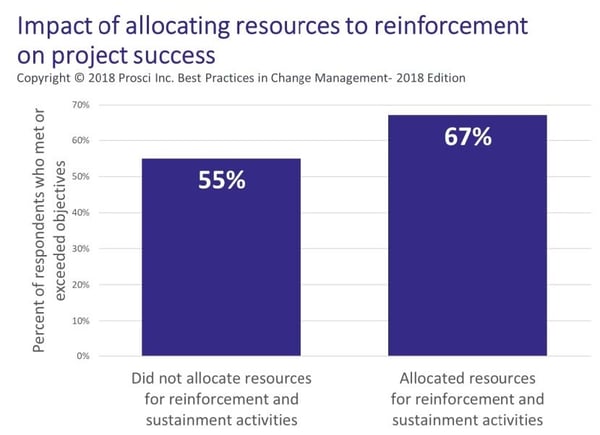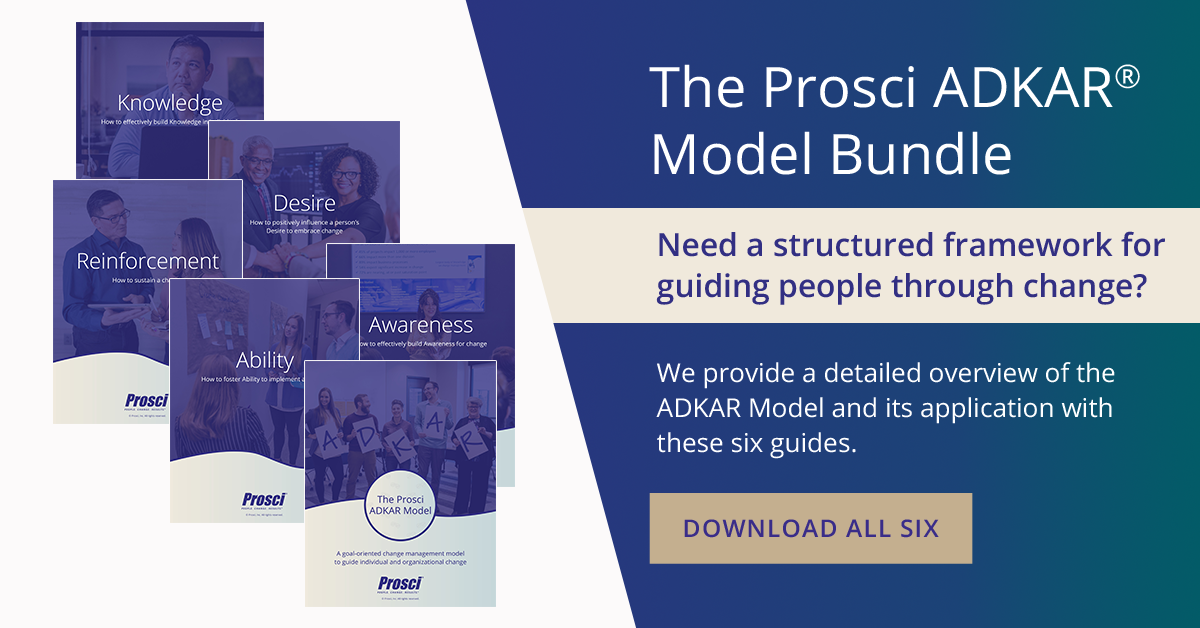It’s ADKAR, Not ADKA Because Reinforcement is Critical to Change

3 Mins
Updated: February 9, 2023
Published: July 12, 2016

The Prosci ADKAR Model gives us the five sequential outcomes individuals must achieve in order to change successfully: Awareness, Desire, Knowledge, Ability and Reinforcement. When individuals put the new skills or behaviors into practice at Ability, that is when the change is realized. So, if the goal is to help people change, why don't we stop at Ability? Why don't we have an ADKA Model instead of ADKAR?
We rarely initiate changes intended to be temporary. We typically strive to make sustained changes. Why would we go to all the effort to progress from Awareness to Ability, unless we intended for that change to stick? We don’t. That’s why Reinforcement is critical—and why it’s ADKAR, not ADKA.
We are creatures of habit. The motivation to move to a new way of doing things may not be sufficient motivation to stay in that new state. If people stay in the “new” state long enough, it will eventually become the “normal” state, and Reinforcement will no longer be needed. But if we do not nurture people from new to normal through Reinforcement, they may backtrack to their old habits, behaviors, processes and archaic spreadsheets.
Reinforcement Impacts Results
Prosci's Best Practices in Change Management research shows that planning for Reinforcement is critically important, especially when it comes to achieving project results. Of the participants who planned for Reinforcement in their projects, 67% met or exceeded their project objectives. Of the participants who did not plan for Reinforcement, only 55% met their project objectives.

How to Reinforce Change
at the Individual Level
We asked research participants to identify the most impactful activities that reinforced change at the individual level. Here are some excerpts from the research, along with thoughts on each:
1. Communicating success
"Communicate consistently and continuously, including progress updates and short-term successes. Use positive and consistent communications in both one-on-one situations between a supervisor and direct report and with peers in informal settings. Communicate through post-implementation of the project to drive sustained change."
At implementation and shortly thereafter, there is usually a flurry of communication: reporting bugs, responding to questions, and course correction. It can be easy to focus on the reactive, mission-critical (and often problem-oriented) communication. The challenge is to carve out time to communicate about the successes, bright spots and wins.
2. Providing and collecting feedback
"Ensure that feedback is collected at all levels, and demonstrate that feedback was heard. Address both positive and negative feedback using one-on-one and team meeting settings. Provide honest and helpful feedback to end users during implementation and post-implementation."
Feedback is a two-way street, which is critically important in Reinforcement. Providing end-users with feedback provides Reinforcement because it requires end-users to be observed and coached. Charging managers to be the conduit of two-way feedback allows for scalability, but it's important to ensure that managers have clear escalation paths for end-user feedback.
3. Recognizing and rewarding adoption
"Provide a variety of channels for recognition through both one-on-one and team meetings with direct reports. Acknowledge success of both short-term wins and long-term goal achievement. Show appreciation for effort made by individuals. Celebrate success and offer incentives throughout each phase of change."
Again, when a change has gone live, there are almost always issues. It is easy to focus on rectifying the things that aren’t going according to plan. It requires conscious effort to find and celebrate the things that are going right. However, this positive Reinforcement can provide the ongoing motivation to stay in the changed state. Remember, the motivation to enact a change may not be enough to continue a change. Celebration and recognition provide fresh motivation.
4. Providing on-the-job support
"Make support mechanisms available during each phase of change. Provide technical and moral support from super users, change champions, leaders and early adopters. Allow for practicing and trial experiences with the future state. Provide job aids, help desks, and updated process documentation."
On-the-job support can actually contribute to Awareness, Desire, Knowledge, Ability and Reinforcement. When resources are available, particularly people resources like change champions or super users, they can provide just-in-time change management to help people wherever they’re stuck. Whether the question is, “Why are we doing this again?” or a more technical question, on-the-job support can keep people on track throughout the project.
Plan for Reinforcement
Don’t underestimate the power of old habits and discomfort in the future state. Even if people successfully transition, keeping them in the future state requires intentional Reinforcement. Start planning for Reinforcement early in the journey, so your strategies are ready to go as soon as people achieve Ability.



